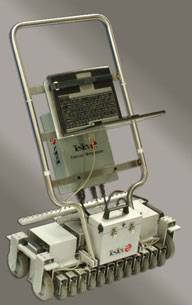TesTex Falcon 2000 Low Frequency Electromagnetic (LFET) Tank Floor Scanner
| Falcon 2000 LFET Scanner | |
 | The TesTex Falcon Mark II LFET Above Ground Storage Tank Floor Scanning System uses the Low Frequency Electromagnetic Technique (LFET) to quickly and accurately inspect ferrous and above-ground storage tank floors. The Falcon Mark II has many packages available based on your inspection needs. Falcons can be mounted on the Viper Crawler system for wall or shell inspection and remotely operated scanners for tank roof inspection. In addition, Falcons complement other products like our Hawkeye system which inspects welds, to provide comprehensive tank inspection solutions. The Falcon 2000 LFET system uses scanners that have 16 or 64 pickup sensors equally spaced to scan flat surfaces covering four inch (102mm) or thirteen inch (330mm) swaths per pass. A 32-channel / 64-sensor scanner called the Mark II is a workhorse used for intermediate or average sized tanks. (See the Falcon Wingspan for larger tanks.) |
| Falcon Jr. | |
 | A 16-channel / 16-sensor LFET scanner called the Falcon Jr., is used for hard to reach areas such as sumps / pumps and under heating coils and internal piping, as well as the annular ring. All scanners work from one electronics platform - a small modular, PC based design and can be used interchangeably. They can be outfitted with an optional encoder and operate from 110 / 220V or battery packs. |
| Falcon Wingspan | |
 | The Falcon Wingspan System is the world's most advanced and compact inspection tool for above ground storage tanks. It has a maximum scanning width of 24 inches and is comprised of 12 sensor pods with individual suspension for lift off compensation. The Falcon Wingspan has many features to enhance inspection capabilities. For example, it has chemically resistant wheels and uses 12V batteries that provide up to 10 hours of operation. These features are based upon TesTex's field experience in testing thousands of storage tanks and input from dozens of NDT inspectors across several industries. The Falcon Wingspan system uses state-of-the-art sensors, electronics, alarm systems, wheels, suspension, manueverability, total system integration and software. It uses PC based / modular electronics using Field Programmable Gate Array (FPGA) technology. The Wingspan's encoder tracks distance and speed information for locating and mapping flaws. The unit can be used in conjunction with our TF-Map software. |
Advantages of LFET Over Competing Technologies
Other methods used for inspecting above-ground storage tanks are Magnetic Flux Leakage (MFL) and Ultrasonic Testing. Magnetic Flux Leakage uses permanent magnets, which adds unnecessary weight and requires a cleaner, sandblasted floor surface, which is expensive and time consuming. In addition, Magnetic Flux Leakage cannot determine whether a flaw is on the top surface or bottom surface of the tank floor and cannot test through coatings.
Like MFL, ultrasonic testing requires a cleaner floor surface and is very time consuming due to the lack of surface area which can be scanned at any one time.
Our Low Frequency Electromagnetic Technique (LFET) products does not use permanent magnets, so they are lightweight (under 30 lbs.) and are easy to handle and transport. LFET based tests require minimal floor preparation; it tests through coatings and determines top surface flaws from bottom surface flaws. Moreover, the Falcon LFET scanners will continue to show flaw responses even after the unit has stopped moving.
TesTex Reporting software generates a tube sheet map for you to examine the results of LFET tube inspections and a tank floor map for LFET tank inspection respectively.